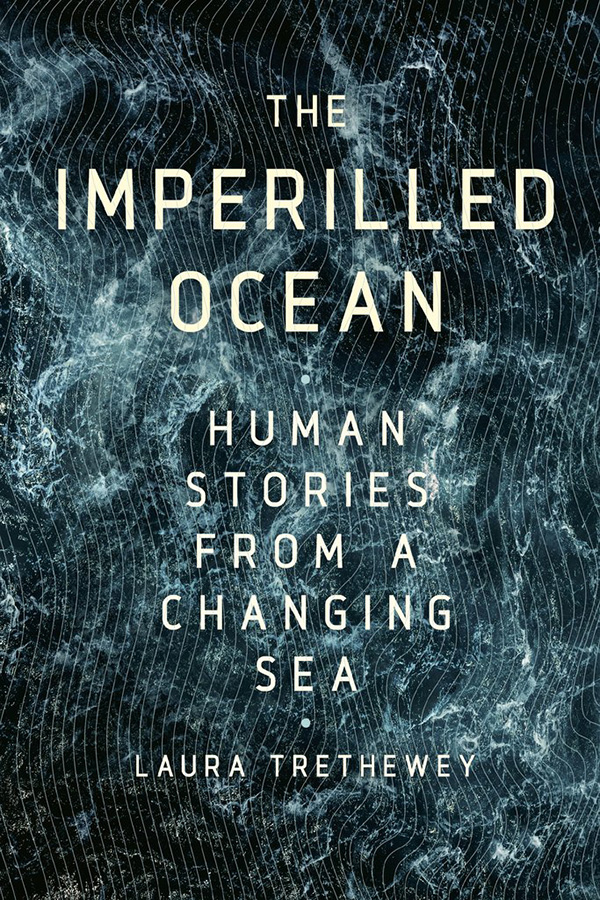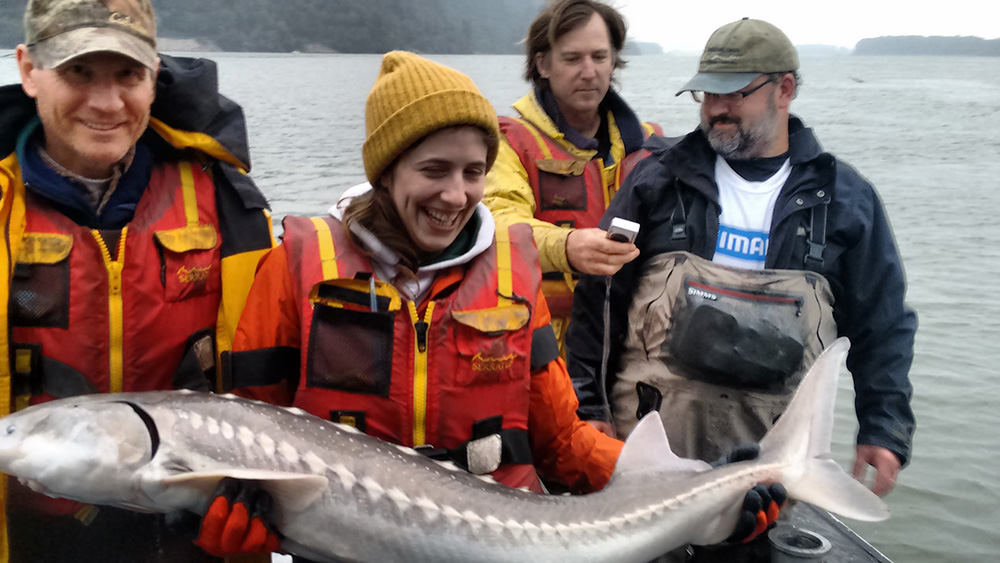- The Imperilled Ocean: Human Stories from a Changing Sea
- Goose Lane Editions (2020)
[Editor’s note: We are proud to feature an excerpt from 'The Imperilled Ocean: Human Stories from a Changing Sea' on The Tyee. Republished with permission from Goose Lane Editions.]
One afternoon not long ago, I looked a fish in the eye and saw something beautiful. Her small pupils revealed a deepening maze of tawny, glistening yellows. Her scales at first looked grey and matte, but when I moved in closer — and I mean nose-to-scale close — her armoured skin became a kaleidoscopic swirl of colours and shapes: purple diamonds, coral glints, blots of black like spilled ink. On each side of her half-moon gills was a starburst of metallic purples and pinks, like she was wearing the most awesome earrings in the world. If it hadn’t been a rainy October day, the quicksilver colours of her skin would have caught the sun.
Then, with a quick flash of her tail, the sturgeon and her hallucinogenic-coloured skin and eyes were gone, released back into the water. Every second she spent with me out of the estuary jeopardized her return to the water. Here in the Fraser River, she and thousands of other white sturgeon like her swim in and out of the Pacific Ocean. It’s where Erin Stoddard, a stocky 53-year-old fisheries biologist, has studied this mysterious fish for 15 years.
The modern world tends to leapfrog from crisis to crisis, headline to headline. Some stories about the ocean make front-page news, like the Great Pacific Garbage Patch or refugees in the Mediterranean. Very rarely does the quiet demise of an uncharismatic mud-trawling fish like the white sturgeon make headlines — unless, of course, that fish goes extinct, which is not impossible today.
Most would not call the sturgeon beautiful. It certainly doesn’t have the aesthetic appeal of a frolicking dolphin or the cuddliness of a big-eyed seal. Instead, it has the plated skin of an alligator, the upright back tail and white belly of a shark, and the beady eyes of a snake. Sturgeon are widely distributed across the northern hemisphere, from rivers in China and Russia to the Great Lakes and the Sacramento River. One of the largest sturgeon ever reeled in on the Fraser River in recent years stretched over 12 feet long, rivalling the length of the boat that caught it, and weighing more than a grand piano. A sturgeon trawls the river bottom, its catfish-like whiskers dragging through the mud, its pointed chin pockmarked with papillae taste buds. It looks like a relic from a fiercer time, perhaps as early as the Carboniferous period according to new research, and the sturgeon’s anatomy has changed remarkably little since it evolved in prehistoric oceans and rivers. This ancient fish has survived, exactly as it is today, for millions of years, not to mention the last six thousand years of modern human history. To fish nerds, this is a cool fish.

Nearly every population of sturgeon around the world is in some sort of trouble. In the mega-dammed, overdeveloped Yangtze River, the wild Chinese sturgeon will likely go extinct before 2030, scientists predict. The once abundant Alabama sturgeon is now so rare it’s gained an almost mythic status in that state. In the Caspian Sea, people have poached and overfished the massive beluga sturgeon to near extinction. In the Lower Fraser River, where Erin Stoddard worked, accumulating and piecing together patchy information about the white sturgeon, this fish swims through some of the most dammed, dyked and developed land in the Pacific Northwest. New ports, new bridges, new dykes, new levies, and new drainage projects are always in the works right in the sturgeon’s habitat. The rush to develop shows no sign of stopping. The International Union for Conservation of Nature has estimated that the sturgeon group of species is more endangered than any other in the world, with 85 per cent at risk of extinction. Aquaculture may be the only future left for sturgeon: already 90 per cent of young beluga sturgeon come from artificial breeding.
At first glance the white sturgeon population in the Lower Fraser River seems healthy. In 2015, around 45,000 sturgeon swam and spawned and fed in the river and out in the Pacific Ocean. This seems like a high number, but it actually hides a worrying reality: sturgeon can live over a hundred years, and many of those fish are on the older side.
“That’s part of the difficulty of being a sturgeon biologist,” said Erin Stoddard. He is directly responsible for the future of white sturgeon in these parts. “Their generations are similar to ours. How can you tell when you’ve come to a recovery state, or when it’s time to do other management, if it takes 30 years to figure that out?”
Along the Fraser River, each new condo development and overpass takes another bite out of the naturally loose gravel along the riverbanks, where sturgeon hide their eggs. Studies show that the next generation is struggling to reach sexual maturity: since 2004, juvenile numbers have declined as much as 50 per cent. Nearby populations in the Columbia, Kootenay and Nechako rivers are in worse condition. For years now, they haven’t had a significant spawn that would boost their numbers. This is particularly worrying in a late-blooming fish like the sturgeon. Males start spawning around 15 years old and later, while females can take 18 years to produce eggs. By the time the next generation arrives, the population may have already suffered a catastrophic, ecosystem-destabilizing decline.
At least we now have a name for this pattern of slow and steady demise of species like the sturgeon: the Anthropocene, which has ushered in the world’s sixth mass extinction. Over the last few environmentally turbulent years, the Anthropocene has moved from scientific discussion to the cover of The Economist. Scientists debate exactly when the Anthropocene began, but most agree we’re already living in it. Plastic pollution is one hallmark of this scary new era. Another is species extinction. Aquatic habitats are threatened from multiple angles: pollution, ocean acidification and warming, coastal development and erosion, invasive species, poaching and overfishing. This time, extinction will not be a matter of chance asteroids but the cumulative actions of one species: our own. ![]()
Read more: Environment
















Tyee Commenting Guidelines
Comments that violate guidelines risk being deleted, and violations may result in a temporary or permanent user ban. Maintain the spirit of good conversation to stay in the discussion.
*Please note The Tyee is not a forum for spreading misinformation about COVID-19, denying its existence or minimizing its risk to public health.
Do:
Do not: